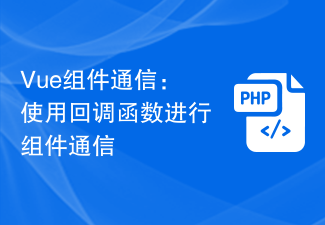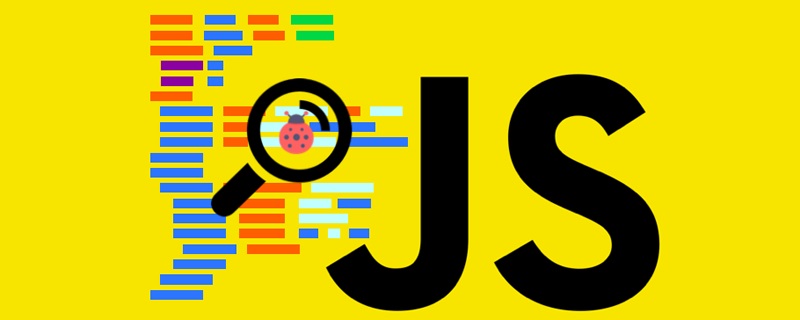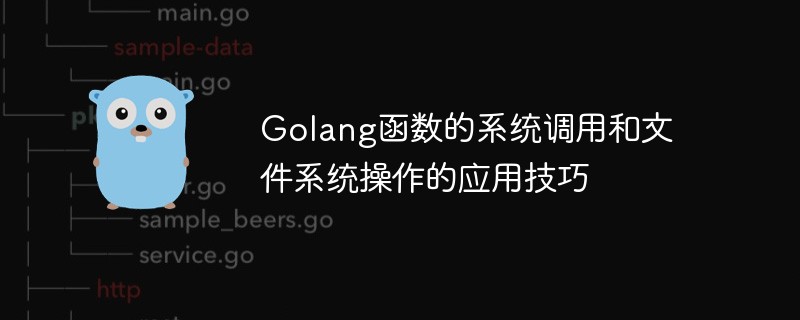Golang is an efficient programming language, and the application of callback functions of its functions is extremely important. Therefore, in this article, we will explain in depth the relevant knowledge of the application of callback functions of Golang functions.
1. What is a callback function?
The callback function is a function pointer, which is passed directly to other functions as a parameter. When this parameter function is executed, our function will be called back. This is the basic concept of the callback function.
2. The syntax of Golang callback function
In Golang, the syntax of callback function is very simple. You only need to pass the function name as a parameter to other functions. For example:
package main
import "fmt"
func main() {
// 定义一个函数,并将它作为参数传递给另一个函数
fm(1,2,func(a,b int) int{
return a+b
})
}
// 定义一个函数,调用回调函数
func fm(a,b int, f func(int,int)int) {
fmt.Println(f(a,b))
}As you can see, in this code, we define a function fm, which receives three parameters, one of which is a callback function. In the main function, we define a callback function and then pass it as a parameter to the fm function.
3. Application of callback function
1. Asynchronous processing
The callback function can implement asynchronous processing. For example, we need to read 1G of data from the database, and at this time We need the user's operation to continue reading. At this time, we can use the callback function to implement asynchronous processing.
package main
import (
"fmt"
"time"
)
func main() {
// 测试异步处理,开始时间
start := time.Now()
// 创建一个异步函数
go doSomething(func() {
fmt.Printf("异步处理完成,消耗时间: %s", time.Since(start))
})
// 主线程
fmt.Println("主线程继续执行")
time.Sleep(time.Second * 4)
}
// 异步函数处理
func doSomething(cb func()) {
fmt.Println("do something")
time.Sleep(time.Second * 3)
cb()
}In this code, we define a doSomething function, which implements asynchronous processing. When doSomething is completed, the callback function cb can be executed. In the main function, we call the doSomething function and exit after waiting 4 seconds in the main thread. When this program is executed, "do something" and "main thread continues execution" will be output first, and then the wait process will execute the callback function cb after the main thread waits for 3 seconds. So the output structure is:
do something 主线程继续执行 异步处理完成,消耗时间: 3.004536386s
2. Logging
Another common example of using callback functions is in logging applications. For example, if we need to record the log information of a specific event, we can use the callback function to achieve this task.
In this example, we will use the callback function to print the log message directly to the console.
package main
import "fmt"
func main() {
// 调用打印日志的函数
logMessage("This is my debug message", func(msg string) {
fmt.Printf("DEBUG: %s
", msg)
})
}
// 记录日志(把日志消息通过回调函数输出到控制台上)
func logMessage(msg string, logger func(string)) {
logger(msg)
}In the above code implementation, we defined a logMessage function, which accepts a callback function as a parameter and prints the message to the console.
We finally call the logMessage function directly in the main function and pass an anonymous function as a callback parameter. This anonymous function will be called in the logMessage function to output a log message on the console.
4. Summary
In this article, we have an in-depth explanation of the relevant knowledge about the application of callback functions in Golang functions. Starting from what a callback function is, to simple callback function syntax, and then to the application scenarios of various callback functions, I hope this article can be helpful to readers.
The above is the detailed content of Golang function callback function application explanation. For more information, please follow other related articles on the PHP Chinese website!
 Golang函数的参数默认值应用技巧May 15, 2023 pm 11:54 PM
Golang函数的参数默认值应用技巧May 15, 2023 pm 11:54 PMGolang是一门现代化的编程语言,拥有很多独特且强大的功能。其中之一就是函数参数的默认值应用技巧。本文将深入探讨如何使用这一技巧,以及如何优化代码。一、什么是函数参数默认值?函数参数默认值是指定义函数时为其参数设置默认值,这样在函数调用时,如果没有给参数传递值,则会使用默认值作为参数值。下面是一个简单的例子:funcmyFunction(namestr
 Golang函数的反射和类型断言的应用和底层实现May 16, 2023 pm 12:01 PM
Golang函数的反射和类型断言的应用和底层实现May 16, 2023 pm 12:01 PMGolang函数的反射和类型断言的应用和底层实现在Golang编程中,函数的反射和类型断言是两个非常重要的概念。函数的反射可以让我们在运行时动态的调用函数,而类型断言则可以帮助我们在处理接口类型时进行类型转换操作。本文将深入讨论这两个概念的应用以及他们的底层实现原理。一、函数的反射函数的反射是指在程序运行时获取函数的具体信息,比如函数名、参数个数、参数类型等
 Vue组件通信:使用回调函数进行组件通信Jul 09, 2023 pm 07:42 PM
Vue组件通信:使用回调函数进行组件通信Jul 09, 2023 pm 07:42 PMVue组件通信:使用回调函数进行组件通信在Vue应用程序中,有时候我们需要让不同的组件之间进行通信,以便它们可以共享信息和相互协作。Vue提供了多种方式来实现组件之间的通信,其中一种常用的方式是使用回调函数。回调函数是一种将一个函数作为参数传递给另一个函数并在特定事件发生时被调用的机制。在Vue中,我们可以利用回调函数来实现组件之间的通信,使得一个组件可以在
 Golang函数的优雅退出和循环遍历跳出小技巧May 16, 2023 pm 09:40 PM
Golang函数的优雅退出和循环遍历跳出小技巧May 16, 2023 pm 09:40 PMGolang作为一门开发效率高、性能优异的编程语言,其强大的函数功能是其关键特性之一。在开发过程中,经常会遇到需要退出函数或循环遍历的情况。本文将介绍Golang函数的优雅退出和循环遍历跳出小技巧。一、函数的优雅退出在Golang编程中,有时候我们需要在函数中优雅地退出。这种情况通常是因为我们在函数中遇到了一些错误或者函数的执行结果与预期不符的情况。有以下两
 详解Golang函数中的变量作用域Jan 18, 2024 am 08:51 AM
详解Golang函数中的变量作用域Jan 18, 2024 am 08:51 AMGolang函数中的变量作用域详解在Golang中,变量的作用域指的是变量的可访问范围。了解变量的作用域对于代码的可读性和维护性非常重要。在本文中,我们将深入探讨Golang函数中的变量作用域,并提供具体的代码示例。在Golang中,变量的作用域可以分为全局作用域和局部作用域。全局作用域指的是在所有函数外部声明的变量,即在函数之外定义的变量。这些变量可以在整
 深入解析JavaScript中的回调函数(同步和异步)Aug 04, 2022 am 10:05 AM
深入解析JavaScript中的回调函数(同步和异步)Aug 04, 2022 am 10:05 AM回调函数是每个前端程序员都应该知道的概念之一。回调可用于数组、计时器函数、promise、事件处理中。本文将会解释回调函数的概念,同时帮你区分两种回调:同步和异步。
 Golang函数的系统调用和文件系统操作的应用技巧May 17, 2023 am 08:08 AM
Golang函数的系统调用和文件系统操作的应用技巧May 17, 2023 am 08:08 AM随着计算机技术的不断发展,各种语言也应运而生。其中,Golang(又称GO语言)因为其高效、简单、易于学习的特点,在近年来越来越受到开发者们的青睐。在Golang中,函数的系统调用和文件系统操作是常见的应用技巧。本文将详细介绍这些技巧的应用方法,以帮助大家更好地掌握Golang的开发技能。一、函数的系统调用1.系统调用是什么?系统调用是操作系统内核提供的服务
 Golang函数的变量定义时的赋值方法与区别May 17, 2023 pm 07:01 PM
Golang函数的变量定义时的赋值方法与区别May 17, 2023 pm 07:01 PMGolang是一种快速、高效、现代化的编程语言,它在编译时会自动检查类型,并且具有并发性和内存安全性等特点,因此被越来越多的开发者所青睐。在Golang中,我们经常需要使用函数来封装业务逻辑,而函数中的变量定义时的赋值方法是一个常见的问题,本文将详细讲解这个问题并分析其中的区别。变量定义在Golang中,可以使用var和:=两种方式来定义变量。其中,var方


Hot AI Tools

Undresser.AI Undress
AI-powered app for creating realistic nude photos

AI Clothes Remover
Online AI tool for removing clothes from photos.

Undress AI Tool
Undress images for free

Clothoff.io
AI clothes remover

AI Hentai Generator
Generate AI Hentai for free.

Hot Article

Hot Tools

PhpStorm Mac version
The latest (2018.2.1) professional PHP integrated development tool

MantisBT
Mantis is an easy-to-deploy web-based defect tracking tool designed to aid in product defect tracking. It requires PHP, MySQL and a web server. Check out our demo and hosting services.

SublimeText3 Linux new version
SublimeText3 Linux latest version

SecLists
SecLists is the ultimate security tester's companion. It is a collection of various types of lists that are frequently used during security assessments, all in one place. SecLists helps make security testing more efficient and productive by conveniently providing all the lists a security tester might need. List types include usernames, passwords, URLs, fuzzing payloads, sensitive data patterns, web shells, and more. The tester can simply pull this repository onto a new test machine and he will have access to every type of list he needs.

EditPlus Chinese cracked version
Small size, syntax highlighting, does not support code prompt function






